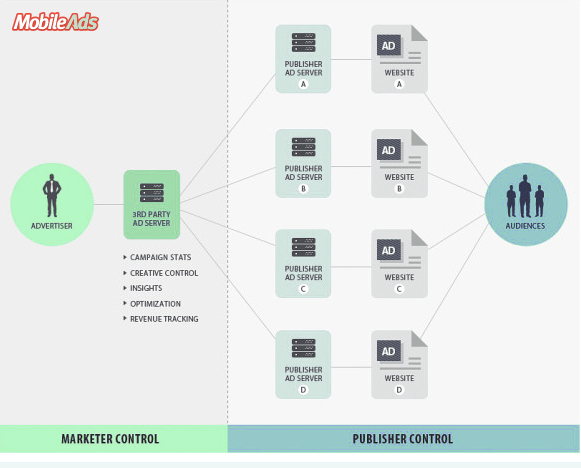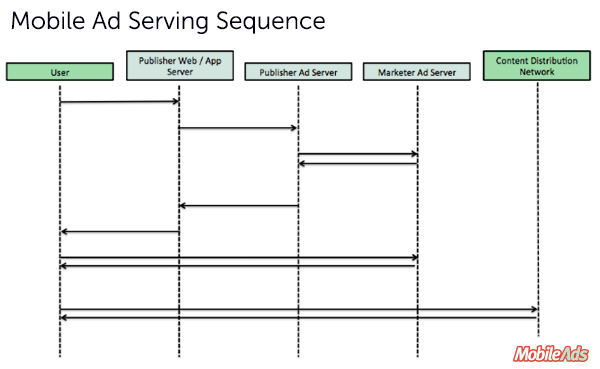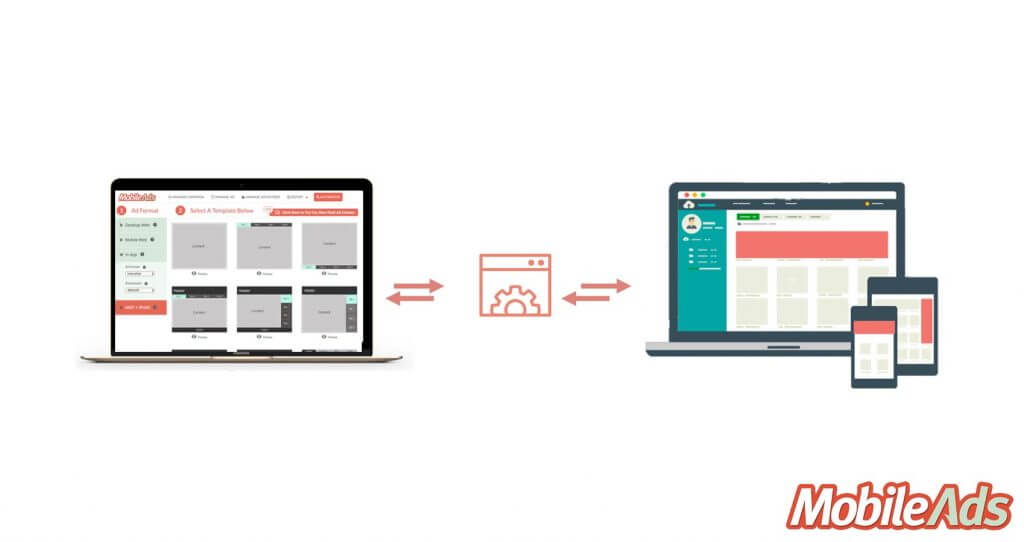The need for a proper mobile ad server is vital. Especially when you look for better control over your ad operations. It is a best practice to use your ad server, especially if you run a consistent volume of...
Ad serving technology companies or ad server platform (publisher & advertiser side), sometimes termed as simply “ad server” Help advertisers serve ads, Help publishers publish ads, Track and count the ads, Choose the ads to be rendered and displayed that which make the publisher or advertiser most money, and Monitor the progress of different advertising campaigns..."} }, { "@type": "Question", "name": "What is the main difference between regular ad server and mobile ad server?", "acceptedAnswer": { "@type": "Answer", "text":"For mobile display advertising, there are some things that an ad server must handle. Some of them include: Targeting based on mobile-specific criteria, i.e. device, operating system, carrier, capabilities of the device, etc., Potential use of precise location info, The need for your ad to work with mobile applications and support the MRAID in-app advertising standard or VAST & VPAID standards for video ads, Connected/certified in mobile ad networks and ad exchanges..."} }, { "@type": "Question", "name": "What Is A Third Party Ad Server?", "acceptedAnswer": { "@type": "Answer", "text":"A third party ad server or a third party ad serving vendor simply refers to a technology company or platform, with expertise in the creation, managing, tracking and optimization of ads – mobile, video or rich media.
Using a third party ad server, an advertiser or agency can more easily manage ads that they serve on multiple websites, apps, and ad networks. A third party ad server supports multiple ad formats, technologies, and channels making ad campaign delivery, management and optimization easier..."}
}]
}
The need for a proper mobile ad server is vital. Especially when you look for better control over your ad operations. It is a best practice to use your ad server, especially if you run a consistent volume of ad campaigns.
But, that’s not always the case for mobile rich media. From rich media ad creator, ad tag generator, server setup to maintenance, namely ad serving and content delivery network (CDN) costs, can be overwhelming for a medium size ad agency or advertiser. You will find that a third-party ad server can be to your great advantage.
In this article, we will share with you some of the reasons why you need a third-party vendor to serve your rich media ads. Also included are the considerations you may need when selecting a third-party rich media ad server.
To appreciate the benefits of a 3rd-party ad server, let’s first try to comprehend the basics of ad servers and how they work.
What is a Mobile Ad Serving?
Ad Serving means the technology and service that places advertisements on websites or apps.
Ad serving technology companies or ad server platform (publisher & advertiser side), sometimes termed as simply “ad server”,
Help advertisers serve ads, Help publishers publish ads, Track and count the ads, Choose the ads to be rendered and displayed that which make the publisher or advertiser most money, and Monitor the progress of different advertising campaigns.There are two types of ad server in the advertising ecosystem: publisher ad server (supply side) and advertiser ad server (demand / buy side).
Here’s a simple illustration of the ecosystem for a better idea of the correlation of these two ad servers.
 Illustrates the relationship between advertiser-side and publisher-side ad servers
Illustrates the relationship between advertiser-side and publisher-side ad servers
Above diagram is an adaptation of original image from SiteScout.
Note: The “ad server” in this article refers to “advertiser ad server / third-party ad server” unless stated otherwise.
Ad Servers offer a variety of features. Some of which are:
Part of an ad network, exchange or demand-side platform (DSP) solution Mobile or desktop ad serving Video ad serving Creative types supported, i.e. image, HTML5 ads, display ads, native ads, rich media, linear/non-linear video, etc. Campaign optimization, i.e. CPM, CPC, CPA, eCPM, conversion tracking, fixed cost, etc. Reporting type, i.e. real-time, dashboard, custom reports, notification alert, API, etc. Targeting solutions i.e. time/day parting, geo, behavioral, location-based, etc.Most ad servers offer a mixture of features while some have limited offerings. And most ad servers today support HTML5 rich media creatives. But, there are distinct differences between a typical versus a mobile ad server.
What is the main difference between regular ad server and mobile ad server?
For mobile display advertising, there are some things that an ad server must handle. Some of them include:
Targeting based on mobile-specific criteria, i.e. device, operating system, carrier, capabilities of the device, etc. Potential use of precise location info The need for your ad to work with mobile applications and support the MRAID in-app advertising standard or VAST & VPAID standards for video ads Connected/certified in mobile ad networks and ad exchangesHow Ad Serving Works — Mobile vs. Web Environments
Referring to the same diagram above, you will notice that the third-party ad server manages its campaigns across four different publishers. This is accomplished by providing each publisher with their unique “ad tag” script. The ad tag script is generated using the advertiser ad server. The tags are inserted into a publisher ad server that is associated with the corresponding website.
For the sake of explanation, I’ll use the simplest ad sequence on a single media buy. I’ll leave programmatic advertising, RTB and ad exchange sequences for other articles.
For both environments, the ad serving sequence as described above differs from one another. Mobile ad servers vary in tracking, speed, and quality.
The following illustrations are based on user’s perspective showing you what happens when an ad call is made for a desktop and mobile.
The ad serving sequence means a bunch of interactions between a client (user’s browser/apps) and a server.
Referring to the desktop ad serving sequence above, you’ll notice that the client does the fetching and redirecting of information in the desktop environment.
Tracking ads on a desktop: The redirecting the client gives each platform the ability to drop or read a cookie. This facilitates
Downstream conversion tracking, frequency measurement, and audience profiling Client-side monitoring of key metrics i.e. clicks and impression for billing purpose.The downside: Desktop ad serving process requires more work from the browser. This is alright for home and office connections with usually high-speed connections and unlimited data usage.
In mobile environments, connection speeds matter. The following diagram shows the mobile ad serving sequence.
Many mobile users are on a rather slow connection. If the browser or app fetches the ad like on desktops, the user is likely to abandon the page before the ad has finished loading.
So, the work is often done in the cloud for mobile ad serving, independent of the client.
Tracking ads on mobile: Cookies not supported. Need more sophisticated tracking like attribution via Apple’s Identifier for Advertisers (IDFA) or Google’s Advertising ID (AAID).
To conclude: The two major differences between the web and mobile environments are
Tracking: desktop uses cookies vs. mobile requires attributions using IDFA or AAID Workload and speed: desktop places more workload on the client vs. mobile depends on cloud processing power for the delivery speedFor both environments, the raw creative graphics and codes (the actual ad) are housed in the Content Delivery Network (CDN).
Why do you need CDN? As powerful as ad servers are, they just aren’t equipped to handle the volume and bandwidth required to deliver content as heavy as image files—especially rich media creatives.
This is also one of the reasons why it costs more to serve rich media ads
Additionally, to run a rich media ad campaign, you will need the tools and services, like a rich media ad creator and engagement tracking, of which a rich media agency usually offers.
Most larger agencies, DSPs, or ad network partner up with 3rd party rich media vendors to provide a complete solution for their brand clients. However, it can get a little pricey and complicated for small-to-mid size agencies or companies.
Besides ad-serving capabilities, these rich media vendors typically do a remarkable job of addressing a lot of challenges like cross-platform, cross-device, and cross-network delivery.
Now, the next question you’d probably be asking is that do all ad servers accept third-party ad tags?
The answer is that most major traffic supply sources, exchanges, and publishers accept these tags with specific conditions. So you’d probably need to ensure that the third-party vendor you work with has done the necessary groundwork, such as ad impression disparity checks and ad tags testing, on the platforms you wish to run your ads.
There are a lot more benefits to hiring a rich media vendor or third-party ad server with rich media capabilities.
Uses of Rich Media Ads for Mobile
Here are some uses of rich media mobile ads:
1. 360-degree view of the product
We live in an era where the eCommerce market is booming at a tremendous rate. Every year hundreds of online shopping portals are opened to provide products belonging to a wide range of categories.
Shoppers are frequently on the lookout for the best deals or their favorite products. Rich media ads help to showcase your product in a 360-degree format. The consumers can rotate the product in 360 degrees and see every nook and corner of it as if seeing it in real life.
This will help to increase the interaction level with the brand.
If you are a brand owner or an advertiser, you can give a stunning appeal to your product by showcasing it through 360-degree viewing.
2. Social Media Advertising
This involves publishing great content on social media platforms, engaging your audience and running social media advertising. As per the recent report, there are an estimated 3.46 billion active mobile social media users worldwide.
While designing rich media ads, you can embed social media links in your campaign, directly taking the user to the specified site.
With social media marketing, marketers can connect with their audience to build brand awareness, boost sales, and increase your brand’s interaction level.
3. Image comparison
Rich media ads for mobile works best if you compare two different features of a specific ad.
Say, for example, a user is browsing for a particular product, and you have the same product with two different features. In such a case, you could display both the versions side by side to showcase the two separate features and allow the user to choose one of his choices.
What Is A Third Party Ad Server?
A third party ad server or a third party ad serving vendor simply refers to a technology company or platform, with expertise in the creation, managing, tracking and optimization of ads – mobile, video or rich media.
Using a third party ad server, an advertiser or agency can more easily manage ads that they serve on multiple websites, apps, and ad networks. A third party ad server supports multiple ad formats, technologies, and channels making ad campaign delivery, management and optimization easier.
You might wonder why not simply build your own ad server? Well, the answer is because besides the hefty cost to maintain an ad server, unless you have a very strong technical team, you’ll need a team of developers, IT and ad operation specialists to run an ad server. Third-party ad servers normally provide some level of technical support which you can leverage on at all times.
7 Reasons why you need a third-party ad server to serve your mobile rich media ads?
Accountability
Ad serving discrepancy is inevitable. Usually, there will be a disparity of ad impression numbers between the ad requests and the actual ad being served. The usual cause is network latency, users closing the ad before the ad completes loading, website speed where the ad is shown, different measurement standards and even fake traffic. The discrepancy usually comes within a threshold, i.e. in between 10% to 20%, for rich media display ads (based on our clients’ feedback). With independent statistics, you can hold your publishers and ad networks accountable.
Creative Control
With third-party ad tags, you can have control over the formats of your ads, when and where (platform) to serve your ads. If you use a platform-agnostic 3rd party ad tag, you can run the same ad creative using different DSPs, ad exchanges, ad networks or even direct publishers. It is good practice to do so, to determine which traffic partners work best. i.e. the quality of traffic, cheaper ad inventory pricing, the volume of ad inventory available, etc.
Insights
With reporting transparency on the main metrics like Secondary Action Rate (SAR), viewability, and impressions, you will have better access and control over your campaign insights, i.e. placement stats, geographic stats, creative stats, and hourly stats, all on multiple levels, to determine what is and what isn’t working.
With rich media campaigns, every event taken within the ad unit is now trackable. With an image or flash ads, the main insight is only click-throughs (CTR). But with rich media campaigns, the ad by itself is akin to an interactive “micro-website”. How a user engages with the ad brings a wealth of information for the advertisers to get better insights and further optimize the campaign.
Centralized Management & Campaign Reporting
You can manage all your campaigns—creatives, ad tag, ad serving, reporting—all in one place without worrying about logistic complexities.
Data Visibility & Control for In-House Analysis
With a reporting dashboard offered by most vendors, you don’t have to rely on publishers or ad networks for campaign analytics and optimization.
Data Freshness
Some vendors offer real-time reporting platform where you can quickly act on it to fully optimize your campaign.
Source of Record for Check & Balance
A third-party ad server makes an excellent source of record for counter-checking on the conversions, impressions or clicks, and pricing/payment with DSPs and publishers.
The caveat: Costs. Despite some ad servers offering free ad serving up to a certain number of impressions, major advertisers will blow those limits away quickly. The costs you will need to consider are rich media creative and ad serving fees, and CDN costs.
Conclusion
Understanding a mobile ad server and how rich media ads are served do help in your ad operations. But, you don’t have to worry about the challenges of owning one. Today, there are a handful of rich media vendors in the market. They offer myriads of mobile rich media ad server capabilities on top of rich media tools and services.
Here are some of the questions you may want to ask when on the look out for third-party ad server with mobile rich media ad solution.
Mobile ad server comparison questions
Are the ad and ad tags platform-agnostic and device-agnostic?
What kind of groundwork do these vendors execute to ensure agnostic ad tags?
Do they test their ad tags and check for disparities with the supply traffic sources, DSPs, and ad exchanges you want to work with?
How do they manage discrepancies?
What are their tracking capabilities?
What kind of creative capacity do they offer? Video? HTML5 formats?
Do they have integrated workflow? If no, what type of solution fit they offer?
Do they have legacy support or solution in place for platform and devices that do not support rich media?
Are there any audience or creative targeting features?
What kind of technical support do they offer?
Are their ad formats compliant with industry standards that can run across major traffic sources? i.e. MRAID, VAST/VPAID
What are their ad serving fees involved? Other hidden fees?
This article is a part of our comprehensive guide on “What Is An Ad Server And Why You Should Use It?”
Come share with us your experience or opinion about mobile ad serving by leaving your comments below. Looking for more information on mobile ad serving? Reach us at MobileAds.














